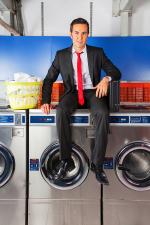SUN CITY WEST, Ariz. — When buying or building a new laundromat, you have three basic goals: 1) you want a busy mat that will be profitable for years, 2) you want to attract customers and then have them return again and again, and 3) you want a good resale value for when you eventually sell.
The day you open your doors, your mat’s condition will begin declining … unless you have a plan to prevent it.
You can keep your equipment looking new for quite a while by changing worn-out keypads and decals, etc., but eventually you have to bite the bullet and retool, lest your mat go downhill and lose its appeal and thus its sales value.
Mats that look like new always attract customers, but the busier your mat is, the more time, effort and money will be required to keep it in that condition.
This month’s topic is less dramatic but just as important. After all, what good is new equipment if your mat is dirty?
Keeping your mat immaculate at all times isn’t always easy but it’s the first proactive thing you can do. It always needs to be very clean to attract “helper customers.” Some customers tend to respect really clean mats more than they do a dirty mat. In the latter, it’s no big deal for a customer to add to the litter, trash and grime because, from the look of things, nobody cares, right?
There are basically two types of cleaning. The first is to simply wipe, sweep, spot-mop and clean as much as possible every hour of every day. The second is deep cleaning, getting at the stuff that slowly builds up.
You Want Surfaces That are Easy to Clean — When building or redoing your mat, keep “easy to clean” in mind when choosing any surfaces. You don’t want porous surfaces where stains can soak in, or highly textured surfaces that are harder to clean.
The exception here is your floor. It should not be high gloss, because then it becomes too slippery when wet.
When trying to decide what surfaces hold up and are easy to clean, visit your local fast-food chain stores for ideas. The amount of dirt, litter and abuse they constantly endure is even more challenging than our industry!
Some Customers Will Help Keep Things Clean, but Most Will Not — Isn’t it great when a customer picks up a rag to wipe down “their” machines? If you only had more customers like that! Maintaining a very clean mat at all times attracts these kind of loyal customers in the first place.
Some other customers will throw things all over, not caring how they are trashing your mat. Then there are those in the middle who won’t help clean but also won’t trash your place.
Sanitize Your Mat — After COVID, people are more aware of germs. Reading that your place is “sanitized” daily is like a breath of fresh air.
Sanitizing can be safe and easy if you use 3% hydrogen peroxide. It’s cheap, odor-free, safer than other disinfectants, and easy to use. It will kill bacteria, spores, viruses and fungi.
You can screw most spray heads directly onto peroxide bottles, which are brown because light exposure can break down the chemical inside.
Spray any surfaces you want, paying attention to things people touch such as doorknobs, touch pads, buttons, handles, ATMs, etc. Let the peroxide sit for about five minutes, then wipe.
If customers see your attendant walking around with a spray bottle, they will be impressed. Some may even tell their friends.
A Clean Mat Isn’t Just About Cleanliness — Want to avoid lawsuits? Keep your floors clean and dry. Spilled liquid detergent or softener is extremely slippery, and even used dryer sheets on the floor can cause a slip-and-fall.
You see, a clean mat is not just about cleanliness. It’s also about safety.
Side note: Install enough cameras to safeguard against fraudulent slip-and-falls.
Low Prices Equals More Effort to Keep Your Mat Clean — Common sense here: the busier your mat becomes, the harder it is to keep clean. If you’re finding it hard to keep things clean, it may be a cue to raise your vend prices.
Low prices attract bargain hunters who care about price more than anything else. With this crowd comes a greater percentage of disrespectful customers. I was amazed at how some people wouldn’t even bother to use our trash pails and just throw everything on the floor!
Assign Someone Specifically to Deep Cleaning — To complete your deep-cleaning tasks reliably, you need to put specific people in charge of them. You can accomplish this without extra pay if they are the only ones who hold the key to the little treasures that show up in the dryer lint compartments.
This makes them responsible, rather than part of a general cleaning policy where crew members can cherry-pick the lint compartments, or pass the buck when the store is not clean.
Every Employee Must Leave the Store Clean at Shift’s End — To just tell your crew that the store must be clean at the end of their shift is always a good idea. (This rule was practically carved in stone in my mats.) If it’s not, they’ll hear it from the incoming shift, who may also report it to you: “Boss, check the cameras at the start of my shift yesterday.”
Posting a list of cleaning duties for each shift is the best way to keep everyone aware of their responsibilities. If a task is not done but it’s right there on your list, the culprit can’t say they didn’t know.
You can have a single “deep cleaner” do all of the tasks, or you can put specific people in charge of specific tasks. Both choices work. But keep in mind that some people actually enjoy cleaning, so see if you can find people like that.
The graveyard shift in a 24-hour mat is especially useful for this.
Check back Thursday for the conclusion...
Have a question or comment? E-mail our editor Bruce Beggs at [email protected].





























